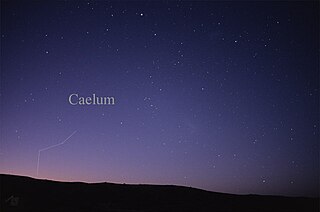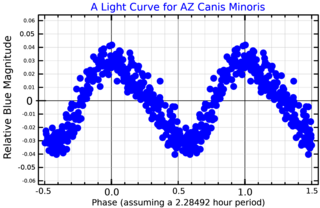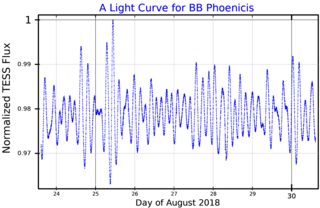
Eta Aquilae is a multiple star in the equatorial constellation of Aquila, the eagle. It was once part of the former constellation Antinous. Its apparent visual magnitude varies between 3.49 and 4.3, making it one of the brighter members of Aquila. Based upon parallax measurements made by the Gaia spacecraft on its third data release (DR3), this star is located at a distance of roughly 272 parsecs. The primary component is a Classical Cepheid variable.

Delta Scuti, Latinized from δ Scuti, is a variable star in the southern constellation Scutum. With an apparent visual magnitude that fluctuates around 4.72, it is the fifth-brightest star in this small and otherwise undistinguished constellation. Analysis of the parallax measurements place this star at a distance of about 199 light-years from Earth. It is drifting closer with a radial velocity of −45 km/s.

Delta Aquilae, Latinized from δ Aquilae, is a binary star system in the equatorial constellation of Aquila. It has an apparent visual magnitude of 3.4 and, based upon parallax measurements, is located at a distance of about 50.6 light-years from Earth. It is drifting closer with a radial velocity of −30 km/s. The system is predicted to come to within 25.4 ly (7.8 pc) of the Sun in around 335,000 years.

Lambda Aquilae, Latinized from λ Aquilae, is a star in the constellation Aquila. It has the traditional name Al Thalimain, which it shares with ι Aquilae. The name is derived from the Arabic الظلیمينal-ẓalīmayn "the two ostriches". Lambda Aquilae is more precisely Al Thalimain Prior. It has an apparent visual magnitude of 3.43, which is bright enough to be seen with the naked eye. Parallax measurements place it at a distance of about 125 light-years from Earth.

12 Aquilae is a star in the equatorial constellation of Aquila. 12 Aquilae has the Bayer designation of i Aquilae and is most easily recognized in the sky being next to the brighter star λ (lambda) Aquilae.
69 Aquilae, abbreviated 69 Aql, is a star in the equatorial constellation of Aquila. 69 Aquilae is its Flamsteed designation. It is visible to the naked eye with an apparent visual magnitude of 4.91. Based upon an annual parallax shift of 16.2 mas, it is located 201 light years away. The star is moving closer to the Earth with a heliocentric radial velocity of −22.5 km/s.
4 Aquilae, abbreviated 4 Aql, is a single, white-hued star in the equatorial constellation of Aquila. 4 Aquilae is the Flamsteed designation. It has an apparent visual magnitude of 5.02, making it a faint star visible to the naked eye. The distance to 4 Aql can be estimated from its annual parallax shift of 6.7 mas, yielding an estimated range of around 480 light years. It is moving closer to the Earth with a heliocentric radial velocity of −13 km/s.

20 Aquilae, abbreviated 20 Aql, is an irregular variable star in the equatorial constellation of Aquila. 20 Aquilae is its Flamsteed designation. It ranges in magnitude from a peak of 5.33 down to 5.36, which is bright enough for the star to be visible to the naked eye. The estimated distance to this star is around 920 light years, based upon an annual parallax shift of 3.5 mas. The star is moving closer to the Earth with a heliocentric radial velocity of −23 km/s.
42 Aquilae, abbreviated 42 Aql, is a single star in the equatorial constellation of Aquila. 42 Aquilae is its Flamsteed designation. It is a dim star but visible to the naked eye under suitable viewing conditions, having an apparent visual magnitude of 5.45. 42 Aql is located some 104.6 light years away, as determined from its annual parallax shift of 31.2 mas. it is moving closer to the Earth with a heliocentric radial velocity of −38 km/s, and is predicted to come to within 52 light-years of the Sun in around 752,000 years.

28 Aquilae, abbreviated 28 Aql, is a star in the equatorial constellation of Aquila. 28 Aquilae is its Flamsteed designation though it also bears the Bayer designation A Aquilae, and the variable star designation V1208 Aquilae. It has an apparent visual magnitude is 5.5, making this a faint star that requires dark suburban skies to view. The annual parallax shift of 9.6 mas means this star is located at a distance of approximately 340 light-years from Earth.
22 Aquilae, abbreviated 22 Aql, is a star in the equatorial constellation of Aquila. 22 Aquilae is its Flamsteed designation. It is a faint star but visible to the naked eye with an apparent visual magnitude of 5.59. The distance to 22 Aql can be estimated from its annual parallax shift of 4.74 mas, which yields a separation of 690 light years. It is moving closer to the Earth with a heliocentric radial velocity of −23 km/s.

10 Aquilae is a star in the equatorial constellation of Aquila. 10 Aquilae is the Flamsteed designation. It has an apparent visual magnitude of 5.9 and thus is a faint star that is just visible to the naked eye in dark skies. The brightness of this star is diminished by 0.17 in visual magnitude from extinction caused by interstellar gas and dust. Based on an annual parallax shift of 13.45 mas, the distance to this star is around 240 light-years.
64 Aquilae, abbreviated 64 Aql, is a star in the equatorial constellation of Aquila. 64 Aquilae is its Flamsteed designation. It is a faint star that requires good viewing conditions to see, having an apparent visual magnitude of 5.97. The distance to 64 Aql, as determined from its annual parallax shift of 21.42 mas, is 152.2 light years. At that distance, the visual magnitude of the star is diminished by an extinction of 0.029 due to interstellar dust. It is moving closer to the Earth with a heliocentric radial velocity of −3.6 km/s.
8 Aquilae is a star in the equatorial constellation of Aquila, located 271 light years away from the Sun. 8 Aquilae is the Flamsteed designation. It can be viewed with the naked eye in good seeing conditions, appearing as a dim, yellow-white hued star with an apparent visual magnitude of 6.08. The star is moving further from the Earth with a heliocentric radial velocity of +12 km/s.

X Caeli, or Gamma2 Caeli, is a binary star system in the southern constellation of Caelum. It is barely visible to the naked eye with an apparent visual magnitude of 6.32. based upon an annual parallax shift of 9.6 mas, it is located 341 light-years from Earth. The system is moving further away with a heliocentric radial velocity of +6 km/s.

V923 Aquilae is a variable binary star system in the equatorial constellation of Aquila. It has the designation HD 183656 from the Henry Draper Catalogue; V932 Aql is the variable star designation. The system is dimly visible to the naked eye with an apparent visual magnitude that fluctuates around 6.06. It is located at a distance of approximately 890 light years from the Sun based on parallax, but is drifting closer with a radial velocity of around −26 km/s.

TT Aquilae is a Classical Cepheid variable star in the constellation Aquila.

AZ Canis Minoris is a variable star in the equatorial constellation of Canis Minor. It is just visible to the naked eye in good viewing conditions as a dim, white-hued star with an apparent visual magnitude of around 6.46. The star is located around 500 light years away from the Sun based on parallax, and is drifting further away with a radial velocity of +15 km/s. No evidence has been found for a companion to this star, although in the past it has been reported as a binary star system.

BB Phoenicis is a variable star in the constellation of Phoenix. It has an average visual apparent magnitude of 6.17, being visible to the naked eye with excellent viewing conditions. From parallax measurements by the Gaia spacecraft, it is located at a distance of 448 light-years from Earth. Its absolute magnitude is calculated at 0.6.

FG Virginis is a well-studied variable star in the equatorial constellation of Virgo. It is a dim star, near the lower limit of visibility to the naked eye, with an apparent visual magnitude that ranges from 6.53 down to 6.58. The star is located at a distance of 273.5 light years from the Sun based on parallax measurements, and is drifting further away with a radial velocity of +16 km/s. Because of its position near the ecliptic, it is subject to lunar occultations.











